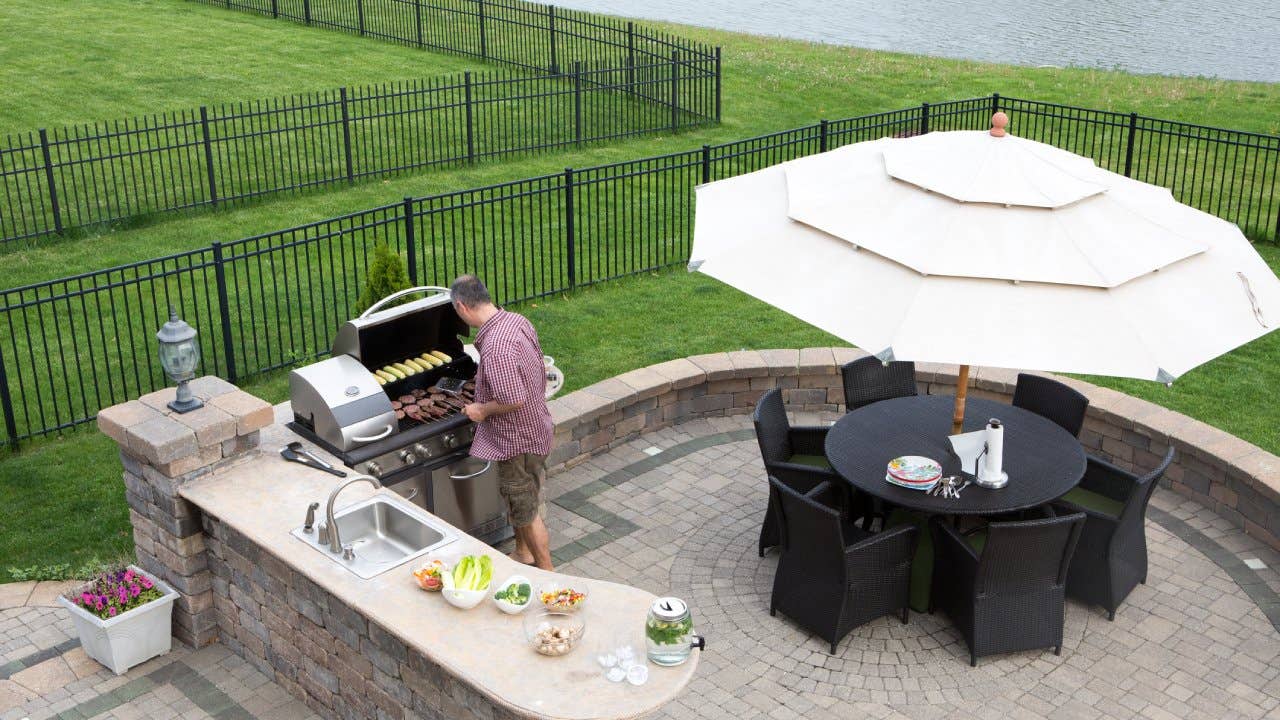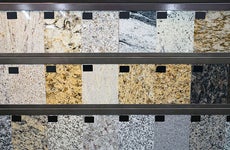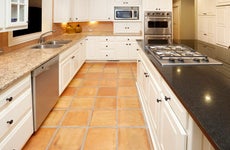What does an outdoor kitchen cost?

The Bankrate promise
At Bankrate we strive to help you make smarter financial decisions. While we adhere to strict , this post may contain references to products from our partners. Here's an explanation for .
Two years of pandemic-enforced isolation have left one lasting legacy: Homeowners seeking to expand their exteriors into functional living spaces — creating extra rooms, in effect to work, play and cook in. Yes, we said “cook”: Outdoor kitchens are sizzling in popularity. A recent HomeLight real estate agent survey reported them as the no. 1 pool-area desired upgrade, and the American Institute of 2022 Q1 Architects Home Design Trends Survey found that 55 percent respondents (55 percent) are reporting increases in outdoor kitchen requests.
Including everything from appliances to countertops, outdoor kitchens come with a considerable range (pun intended) in price: from $5,489 to $22,08, according to HomeAdvisor, though some can soar as high as $40,000.
Here’s what you need to know about adding an outdoor kitchen to your home.
What is an outdoor kitchen?
An outdoor kitchen goes far beyond the lone grill and sideboard. A designated area to prep, cook and clean, it includes (at the least) a countertop, cabinets, and cooking appliances — usually a barbecue grill, typically in pride of place at the center. More elaborate stations often include a sink, a refrigerator, a bar, cooling fans, and secondary cooking devices/appliances: smoker, pizza oven, regular oven, stove top, or an additional grill. They might have a floor and a covering, and also feature extras like TVs, heaters, fire pits and dining tables or islands.
You can create an outdoor kitchen in many different shapes. The most basic is a straight, standalone counter. L-shaped, U-shaped, split-level and a three-quarter square are other popular designs.
Types of outdoor kitchens
Outdoor kitchen design ideas are infinite, but outdoor kitchens themselves come in two basic categories.
Prefab vs custom-built outdoor kitchens
Prefab kitchens are kits that come with the basics: an island for food prep, a drop-in gas grill, and doors to access the propane tank. You can also purchase add-ons like a fridge, granite countertops and other components. Prefab kitchens generally run from $2,000 to $30,000.
In the other corner are custom-built outdoor kitchens. Done entirely to your specs, these require a contractor’s finesse, as you design larger layouts, custom counter materials, integrated appliances and storage. You create any configuration and combination of styles (from rustic to contemporary) you want. Not surprisingly, customized costs more: between $3,000 to $50,000, depending on how extensive you want the kitchen and backyard dining area to be.
Satellite vs perimeter outdoor kitchens
The other big choice is whether to have the outdoor kitchen connected to your home or not.
A satellite kitchen occupies a space of its own, separate from the house. As a result, you’ll need separate hookups for electric or natural gas. Meanwhile, perimeter kitchens align with the layout of your house. The area can share flooring, walls, and the same energy sources as your home.
Perimeter kitchens work best in cozy spaces, or if your interior kitchen fronts your backyard. You’ll have limitations on design and configuration, as they must conform to the location of the existing electric or gas lines. Of course, they may not need as many features, since they’re close to the house, effectively an extension of the regular kitchen.
Alternatively, freestanding satellite kitchens give you the space to let your imagination rip. But they require bigger areas, usually, and will incur higher construction and installation costs — maybe even requiring permits. You or the contractor have to do more work in setting up the appliances (since they cannot use the same energy source as your home), and with the added energy sources comes higher utility bills when in use.
Portable outdoor kitchen
One unique idea is to create a movable kitchen. You dedicate a space for the cooking appliance (often a grill) and a cart to function as your sideboard/countertop. You can roll both to the area when in use. Not only do you increase the functionality of the space, but the costs are also more manageable, ranging from $300 to $3,000.
How much do outdoor kitchens cost?
The majority of homeowners spend $13,000 on their outdoor kitchens. If you plan to use professional help — general contractors, plumbers, electricians, or concrete specialists — expect labor costs to account for 70 percent of your total expenses, according to Fixr.com.
Outdoor kitchens are typically priced per square foot. A typical range is between $40 and $130 a square foot. But the features, the materials you use, size, and location all play vital roles in your final price tag.
Here’s how integral components impact costs:
| Component | Costs per square foot (installed) |
|---|---|
| Source: Fixr | |
| Countertops | $10-$100 |
| Cover | $25-$100 |
| Patio | $40-$100 |
| Cabinets (framing) | $200-$600 |
| Plumbing | $300-$1,500 |
| Lighting | $500-$3,000 |
| Appliances | $1,500-$7,000 |
Location
A satellite kitchen runs you $110 to $130 per square foot. Conversely, a perimeter kitchen costs $90-$120 per square foot.
Size
You’ll need at least 100 square feet to build an outdoor kitchen. From there, your costs grow exponentially as the size of your kitchen does. A 100 square foot kitchen runs you $4,000-$15,000, while a 500 square foot kitchen costs between $20,000-$65,000.
Materials
The materials used for the kitchen, its flooring and its fixtures also impact your financial bottom line. Tile is the most affordable option, ranging from $1 to $50 per square foot. Wood runs you $30-$60 per square foot, while quartz is $55-$155. The most expensive choice is stainless steel at $80-$225.
Special considerations for outdoor kitchens
Installing an outdoor kitchen requires a space of at least 100 square feet. Terrain is also a vital ingredient in kitchen design. “The ideal substrate for an outdoor kitchen is level and firm, with good drainage,” Lauren Tingley, owner of The Backyard Master, recommends. “If you have a sloped yard, you may need to create a level space for your outdoor kitchen. This will make it easier to install the countertops, cabinets, and appliances. This can be done by excavating part of the slope or by building up the area with fill dirt.”
In buying fixtures, surfaces and appliances, you need to consider not just style but the weather. Climate shapes the substances to use. “Lower quality materials are more susceptible to rust from sea air, ” states Brian Lee, a carpenter, and founder of Drill and Driver. “You should opt for Marine-grade stainless steel for cabinets and countertops. There are also specific powder coats advisable to make their interior look more natural.”
Other dos for your project, according to Shaun Martin, Owner, Member, and CEO of WeBuyHousesinDenver:
- When choosing a grill, consider the weather (if it gets nippy at night, you will need a grill that produces more heat, right?)
- Design a layout dependent on your needs, not your wants.
- Budget for heaters to increase the kitchen’s use (al fresco dinner parties well into autumn!)
Bottom line on outdoor kitchens
Outdoor kitchens aren’t bad at recouping their costs, offering a 71% average return on your outlay, according to the HomeLight Top Agent Insights Summer / Fall 2021 Report. Nationwide, the estimated value of an outdoor kitchen has increased 58 percent since pre-pandemic days. And of course, anything that adds to a home’s living space tends to increase its value overall.
While you should build it primarily for your own pleasure, there are some things you can do to spice up your outdoor kitchen’s value. “First, make sure the layout is well-planned and efficient,” says Tingley. “Second, use high-quality materials that can withstand the elements. Finally, don’t forget the little details that can make a big difference. Accent lighting will create an inviting space that your family and friends will love.”
Related Articles



